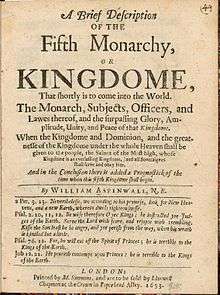Fifth Monarchists
The Fifth Monarchists or Fifth Monarchy Men were an extreme Puritan sect[1] active from 1649 to 1660 during the Commonwealth, following the English Civil Wars of the 17th century.[2] They took their name from a prophecy in the Book of Daniel that four ancient monarchies (Babylonian, Persian, Macedonian, and Roman) would precede the kingdom of Christ. They also referred to the year 1666 and its relationship to the biblical Number of the Beast indicating the end of earthly rule by carnal human beings. They were one of a number of nonconformist dissenting groups that emerged around this time.

Restoration
After the Restoration on 14 October 1660 Major-General Thomas Harrison was the first person to be found guilty of the regicide of Charles I. He had been the seventeenth of fifty-nine commissioners (judges) to sign the death warrant of the king in 1649. He was the first regicide to be hanged, drawn and quartered because he was considered by the new government to represent a continued real threat to the re-established order. This threat was realised when, on 6 January 1661, fifty Fifth Monarchists, headed by a wine-cooper named Thomas Venner, from their alleged hideout in Norton Folgate[3] made an effort to attain possession of London in the name of "King Jesus". Most of the fifty were either killed or taken prisoner, and on 19 and 21 January Venner and ten others were hanged, drawn and quartered for high treason.
The failure of Venner's Rising led to repressive legislation to suppress non-conformist sects. Although some physical events such as the Great Plague of London and the Great Fire of London continued to encourage belief in "the end of the world" ruled by carnal human beings, the doctrine of the sect either died out or became merged in a milder form of Millenarianism.
See also
References
- "Pepys and Evelyn, chroniclers of the English Renaissance". The Economist. 31 Aug 2017.
- Fifth Monarchy Men: Study in Seventeenth Century English Millenarianism by Bernard Capp ISBN 0-571-09791-X
- H. W. Sheppard, English Heritage, 'The Manor and Liberty of Norton Folgate', Survey of London: volume 27: Spitalfields and Mile End New Town (1957), pp. 15-20, citing Cal. S.P. Dom., 1661–2, p. 71.
Further reading
- Burrage, Champlin. "The Fifth Monarchy Insurrections," The English Historical Review, Vol. XXV, 1910.
- Capp, Bernard. "A Door of Hope Re-opened: The Fifth Monarchy, King Charles and King Jesus," Journal of Religious History, (2008) 32#1 pp 16–30
- Hill, Christopher. The World Turned Upside Down: Radical Ideas During the English Revolution (1984) excerpt and text search
- Maclear, J. F. "New England and the Fifth Monarchy: The Quest for the Millennium in Early American Puritanism," William and Mary Quarterly (1975) 32#2 pp. 223–260 in JSTOR
- Solt, Leo F. "The Fifth Monarchy Men: Politics and the Millennium," Church History (1961) 30#3 pp. 314–324 in JSTOR
External links
| Wikisource has the text of the 1911 Encyclopædia Britannica article Fifth Monarchy Men. |
| Wikimedia Commons has media related to Fifth Monarchy Men. |
- Fifth Monarchists or Fifth Monarchy Men
- The Times of Stephen MUMFORD. See the sections on "John James", "Efforts at Conformity" and "Fifth Monarchy Views".
- Some account of the life and opinions of a fifth-monarchy-man By John Rogers, Edward Rogers, Longmans, Green, Reader & Dyer, 1867